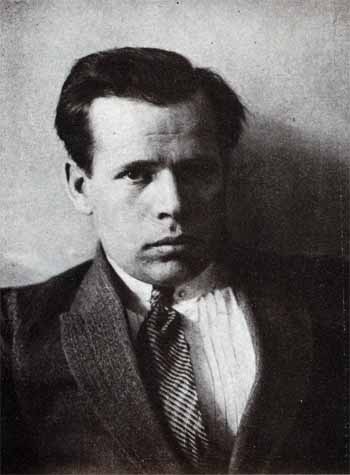Kopylenko, Oleksander
Kopylenko, Oleksander [Копиленко, Олександер], b 1 August 1900 in Kostiantynohrad, Poltava gubernia, d 1 December 1958 in Kyiv. Writer. In the 1920s he belonged to the writers’ groups Pluh, Hart, Vaplite, and Prolitfront. His prose works of the 1920s—including the story collections Kara-Krucha (1923) and Imenem ukraïns'koho narodu (In the Name of the Ukrainian People, 1924), the novel Buinyi khmil' (Wild Hops, 1925), the story collection Tverdyi materiial (Hard Material, 1928), and the novel Vyzvolennia (Liberation, 1930)—depict the revolutionary and early Soviet years in Ukraine in the expressionist manner of Mykola Khvylovy. The last two publications were subjected to severe Communist Party criticism for their ‘pessimistic’ and ‘individualistic’ approach.
Kopylenko was one of the first members of Vaplite to accept the Party’s dictates on literature, and he managed to survive the Stalinist terror as one of the organizers of the Writers' Union of Ukraine. His novel Narodzhuiet'sia misto (The City Is Being Born, 1932) was an early socialist-realist work about industrialization. His novels for adolescents— Duzhe dobre (Very Good, 1935) and Desiatyklasnyky (The Tenth Graders, 1938)—are considered his best works. His postwar novel Leitenanty (Lieutenants, 1947) is a typical hackneyed Soviet work about postwar reconstruction. His last novel, Zemlia velyka (The Great Earth, 1957), is an attempt at a more serious treatment of the life of the rural intelligentsia, careerism, and bureaucratization. In addition to many stories for adults and children, Kopylenko wrote several dramas, including Khurtovyna (The Tempest, 1943) and Chomu ne hasnut' zori (Why the Stars Don’t Go Out, 1944). His expurgated works in four volumes were published posthumously in 1961–2.
BIBLIOGRAPHY
Svider, P. Oleksandr Kopylenko: Zhyttia i tvorchist’ (Kyiv 1960)
———. Oleksandr Kopylenko (1900–1958) (Kyiv 1962)
Kopylenko, Ts. and L. (eds). Pro Oleksandra Kopylenka: Spohady (Kyiv 1971)
Ivan Koshelivets
[This article originally appeared in the Encyclopedia of Ukraine, vol. 2 (1988).]
